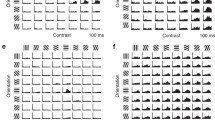Abstract
The properties of 149 neurons, divided into two groups, were investigated during acute experiments on immobilized cats. These consisted of "timers" (37%) in which latency of response and time taken for reaction to peak changed in an orientation range of not more than 10 msec. The remaining 63% consisted of "scanners" [2]. "Timers" reliably differed from "scanners" in their shorter latent periods, rising time of discharge rate, duration of response, and higher rate of impulsation at all orientations of the stimulus. "Scanners" display greater orientational tuning and "scan" much more frequently throughout the orientation range. The pattern of acuity of orientational tuning is counterphasic during response in neurons of these two groups, while the distribution of their preferred orientation is complementary in nature. Both timers and scanners were found in the orientation columns of the visual cortex on most occasions, with the latter predominating. Columns consisting of only timers or scanners were met with more seldom. The significance of the differences between the properties of the two groups of neurons in the visual cortex is discussed with a view to orientational discrimination.
Similar content being viewed by others
Literature cited
N. F. Podvigin, Dynamic Properties of Neuronal Structures of the Visual System [in Russian], Nauka, Leningrad (1979).
I. A. Shevelev, Neurons of the Visual Cortex [in Russian], Nauka, Moscow (1984).
I. A. Shevelev, N. A. Lazareva, R. V. Novikova, and A. S. Tikhomirov, "Conformity and invariability in the discriminatory tuning of neurons in the visual cortex orientation columns," Neirofiziologiya,17, No. 2, 175–182 (1985).
I. A. Shevelev and I. V. Maksimova, "Adaptation of the receptive fields of the visual cortex" in: The Sensory Systems [in Russian], Nauka, Leningrad (1979), pp.62–78.
I. A. Shevelev, V. G. Marchenko, and V. B. Bal'tsev, "A general photic stimulator for investigating the human and animal visual system," in: Methods and Materials for Neurophysiological Research [in Russian], Nauka, Moscow (1976), pp. 63–67.
I. A. Shevelev and G. A. Sharaev, "Pattern of orientational tuning in cat visual cortex neurons," Neirofiziologiya,13, No. 5, 451–459 (1981).
I. A. Shevelev and G. A. Sharaev, "Scanning of orientational range in neurons of the cat visual cortex," Dokl. Akad. Nauk SSSR,256, No. 6, 1506–1509 (1981).
I. A. Shevelev and G. A. Sharaev, "Timers and scanners amongst orientation discriminators in the visual cortex," Neirofiziologiya,17, No. 1, 35–43 (1985).
C. Enroth-Cugell and J. G. Robson, "The contrast sensitivity of retinal ganglion cells of the cat," J. Physiol.,187, No. 3, 517–552 (1966).
D. H. Hubel and T. N. Wiesel, "Receptive fields, binocular interaction and functional architecture in the cat's visual cortex," J. Physiol.,160, No. 1, 106–154 (1962).
D. H. Hubel and T. N. Wiesel, "Receptive fields and functional architecture in two nonstriate visual areas (18 and 19) of the cat," J. Neurophysiol.,28, No. 3, 229–289 (1965).
M. Imbert, "Maturation of visual cortex with and without visual experience," in: Developmental Neurobiology of Vision, Plenum Press, New York (1979), p. 43.
D. E. Nielsen, "A functional model of the wiring of the simple cells of visual cortex," Biol. Cybern.,47, No. 3, 213–222 (1983).
G. A. Orban, E. Vandenbussche, and R. Vogels, "Human orientation discrimination tested with long stimuli," Vision Res.,24, No. 2, 121–128 (1984).
G. A. Orban, E. Vandenbussche, and R. Vogels, "Meridional variations and other properties suggesting that acuity and orientation discrimination reply on different neuronal mechanisms," Ophthalmol. Physiol. Opt.,4, No. 1, 89–93 (1984).
Additional information
Institute of Higher Nervous Activity and Neurophysiology, Academy of Sciences of the USSR, Moscow. Translated from Neirofiziologiya, Vol. 18, No. 1, pp. 85–92, January–February, 1986.
Rights and permissions
About this article
Cite this article
Lazareva, N.A., Novikova, R.V., Tikhomirov, A.S. et al. Different properties of two groups of orientation discriminators in the cat visual cortex. Neurophysiology 18, 68–74 (1986). https://doi.org/10.1007/BF01052494
Received:
Issue Date:
DOI: https://doi.org/10.1007/BF01052494




